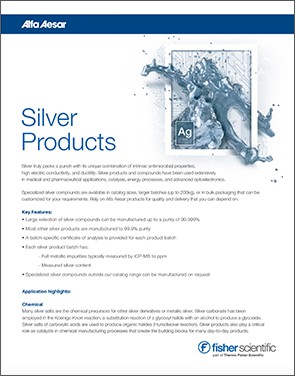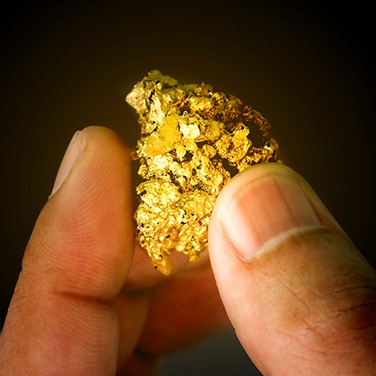Learn and Shop: Precious Metals
The periodic table of elements includes metals, nonmetals, and everything in between. Elements are arranged in order of increasing atomic number, producing an organizational structure that coincides with their physical and chemical properties.
Nature’s Treasures
Classified as transition metals, elements like silver, platinum, palladium, rhodium, and gold make up the largest section of the periodic table. Most are strong and shiny, have high melting and boiling points, and are good conductors of heat and electricity.
Some transition metals, like the ones previously mentioned, have another classification: precious metals. Though this additional categorization isn’t indicated on the periodic table, these elements play a significant role in society and hold value. Throughout history, they’ve been traded as currency, made into jewelry, used in electronics, and so much more.
Samarium (Sm)
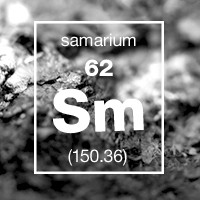
First discovered in 1879, samarium is a bright, silvery white metal and a solid at room temperature. Though mostly stable in dry air, it will develop an oxide coating in moist air. At temperatures above 150˚C, it ignites.
Samarium is found in a number of minerals, including monazite, bastnaesite, and samarskite. Classified as a rare earth element, it’s often found with other lanthanides and obtained using ion exchange and solvent extraction.
This element serves a variety of purposes and has been used in carbon-arc lighting, optical glass and lasers, and as a neutron absorber. In combination with cobalt, it’s used to create powerful magnets that maintain their properties at high temperatures. When combined with oxygen, it can be used as a catalyst. Samarium has also helped miniaturize headphones and personal stereos.
Featured Products
Scandium (Sc)
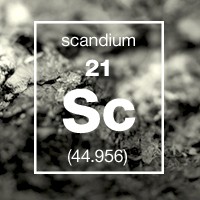
Scandium is a silvery metal that tarnishes when exposed to air. It also reacts when exposed to water and will burn with a yellow-red flame. Discovered in 1878, it’s rarely found in nature but can occur in over 800 minerals. That said, scandium is primarily obtained from thortveitite, bazzite, and wiikite.
With a low density and high melting point, scandium is often alloyed with aluminum to make athletic equipment such as baseball bats, bicycle frames, and lacrosse sticks. It’s considered a high-performance material and its properties also make it applicable to the aerospace industry.
When combined with iodide, scandium contributes to highly efficient light sources that help filmmakers recreate sunlight indoors. Because scandium is expensive, it’s most often used for research purposes.
Yttrium (Y)
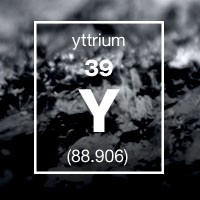
Discovered in 1794, yttrium is a soft, silvery element found in nearly all rare earth metals. It’s relatively stable in air because of an oxide film that forms on its surface, but smaller pieces of yttrium, such as shavings or turnings, can ignite at temperatures over 400˚C. When exposed to water, it will react and produce hydrogen gas.
Yttrium is mostly found in monazite sand, as well as bastnaesite. Not often used in its pure form, it’s instead alloyed with other metals, including aluminum and magnesium, for strength.
Many of its compounds are used in everyday products like color televisions. Yttrium oxide gives the glass in camera lenses a resistance to heat and shock. And yttrium and iron are combined and used in microwave filters.
Neodymium (Nd)
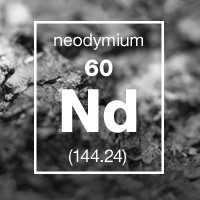
Neodymium was first discovered in 1885 by the Austrian chemist Carl Auer von Welsbach. It’s considered a rare earth element and is found in mineral deposits of monazite and bastnaesite. Known as one of the more reactive lanthanides, neodymium will also tarnish quickly when exposed to air, losing its metallic luster.
When alloyed with iron and boron, neodymium is used to make permanent magnets. The discovery of this application led to the production of smaller cell phones, microphones, and other electronic devices. Magnets made with neodymium are used in electric and hybrid vehicle motors as well.
This element is also a component of colored glass, contributing shades of purple. Glass made with neodymium is often used to make protective goggles for welders and glass blowers.
Gold (Au)
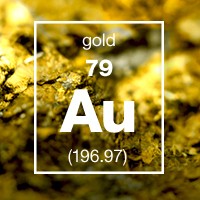
Gold is not only shiny, it’s a great conductor of heat and electricity. It is both ductile and malleable and doesn’t tarnish or corrode. Because it’s so soft, gold is usually alloyed with other metals, including silver, copper, platinum, and palladium, to gain strength.
Known for its use in jewelry, dental fillings, and coins, gold is also an effective addition to electrical connectors and circuit boards. It’s found in nature in veins and alluvial deposits, usually with silver, quartz, calcite, lead, and other metals.
Gold nanoparticles are also being used in the development of a new generation of broad-spectrum antiviral drugs and as antibiotic, antifungal, and antimicrobial agents. Mostly unaffected by air and chemicals, some of gold’s 18 isotopes are used in medicine to treat cancer and arthritis.

Gold Products Data Sheet
Download Now (PDF, 221 KB)
Rhodium (Rh)
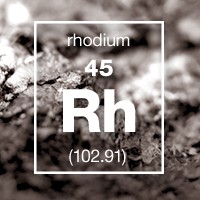
Rhodium, similar to other precious metals, is silvery white. It’s highly resistant to corrosion and very reflective. Discovered in 1803, rhodium is usually found with deposits of platinum. The two are combined to produce aircraft turbine engines.
Along with platinum and palladium, rhodium is used as an automotive catalyst to reduce nitrogen oxides in exhaust gases. And because of its reflective nature, rhodium is used as a finish for jewelry, mirrors, and search lights. It’s also a component of electrical connections.
Rhodium is also used in industrial process chemistry for hydrogenation, hydroformylation, and carbonylation reactions, cornerstones in the production of chemical building blocks and everyday materials. It serves as a catalyst for making chemicals such as nitric acid and acetic acid.
Featured Products
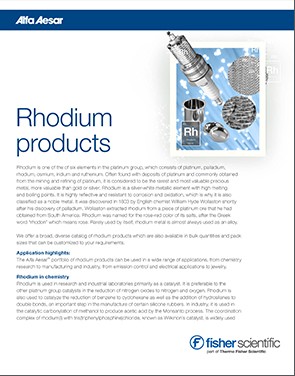
Rhodium Products Data Sheet
Download Now (PDF, 238 KB)
Palladium (Pd)
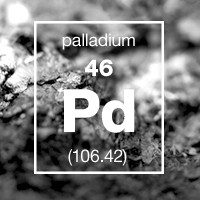
Palladium is a silvery white metal that maintains its color for life. It’s malleable, durable, and nontoxic, and has a low melting point and density in comparison to other metals in its group. First extracted in 1803, it’s believed that miners were aware of its presence as early as 1700.
Primarily used in emissions control devices like catalytic converters, it’s also found in electronics like laptops and cell phones and used to make jewelry that won’t tarnish. Palladium is used in medicine to treat the early stages of prostate and breast cancers and dentistry for inlays, crowns, and bridges.
Cross-coupling reactions like Heck, Negishi, and Suzuki use palladium reagents as catalysts, a significant use recognized in 2010 with a Nobel Prize in chemistry.
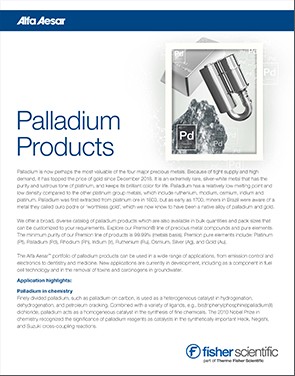
Palladium Products Data Sheet
Download Now (PDF, 213 KB)
Platinum (Pt)
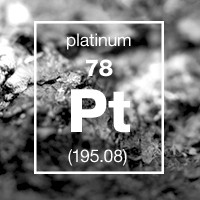
Pure platinum is shiny, silvery white, soft, dense, malleable, and ductile. It’s commonly used as a catalyst and is very resistant to corrosion. Found in catalytic converters, this element helps produce less harmful vehicle emissions.
A transition metal, platinum occurs in nature and has many uses. It’s found in jewelry, wiring and electrical contacts, and dental fillings, as well as laboratory vessels and instruments. Platinum is also incorporated into products that experience high temperatures and require consistent performance, including missile nose cones and jet engine fuel nozzles.
One compound, platinum oxide, is highly insoluble and thermally stable. A dark brown powder, it’s used for glass, optic, and ceramic purposes. Platinum oxide is also known as Adam’s catalyst and plays a role in hydrogenolysis, hydrogenation, dehydrogenation, and oxidation reactions.
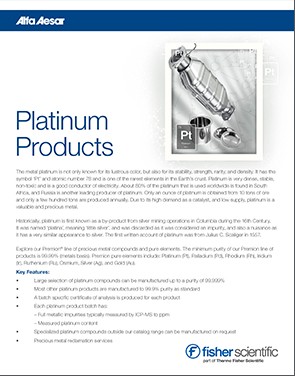
Platinum Products Data Sheet
Download Now (PDF, 181 KB)
Silver (Ag)
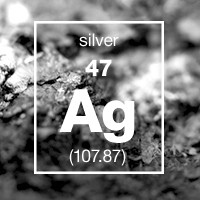
Pure silver is white, soft, shiny, malleable, and ductile. It also has the highest electrical and thermal conductivity of any element. Found in nature as a pure substance, it forms alloys with gold, other metals, and minerals.
Silver isn’t as rare or expensive as other precious metals, and though it’s been used in jewelry and as currency, it’s also important in other industries, like industrial and pharmaceutical process chemistry. It can be used to make solar panels, dental fillings, electrical connectors, and, because of its antimicrobial properties, medical products.
Silver acts as a catalyst in oxidation reactions and is a key component of compounds like silver nitrate, the most common precursor to other silver-containing compounds. Silver nitrate is important for oxidation and deprotonation reactions and used to separate mixtures of alkenes by selective adsorption.
